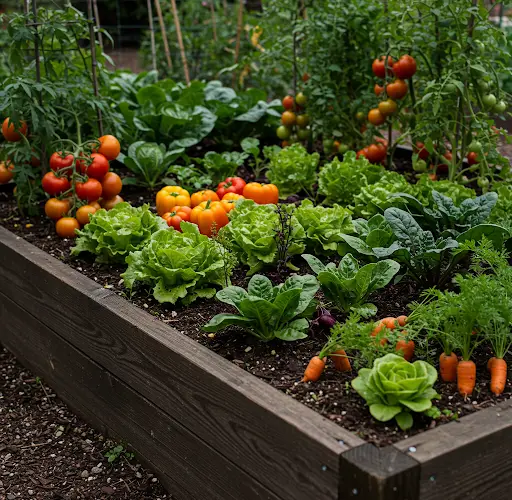How to Transform Your Soil into a Microbial Haven for Thriving Plants
Creating rich, living soil is the foundation of a productive and healthy garden. By nurturing the life within your soil, you provide your plants with everything they need to grow strong, resist pests, and produce abundant blooms and fruits. With a few simple steps and natural ingredients, you can transform compacted, lifeless soil into a fertile haven teeming with beneficial microorganisms.
This method combines time-tested organic materials to improve soil structure, enhance nutrient content, and create the perfect environment for microbial activity—all essential for vibrant plant growth.
Step 1: Loosen the Soil
Before adding any amendments, it’s important to prepare the soil by loosening it. If the ground is compacted or hard, use a shovel, garden fork, or hoe to break it up. Loosening the soil increases aeration and makes it easier for plant roots to grow deeper and stronger. It also allows water and nutrients to penetrate more effectively and helps the amendments mix thoroughly with the soil.
Step 2: Add Bone Meal for Root Development
Once the soil is loosened, it’s time to enrich it. Begin by sprinkling bone meal evenly across the garden bed. Bone meal is a natural source of phosphorus and calcium—two nutrients essential for healthy root systems and robust plant growth. Phosphorus is especially important during early stages of growth and for encouraging flower and fruit production, while calcium supports cell development and strengthens plant structure.
Step 3: Sprinkle Neem Cake Powder
The next addition is neem cake powder. Derived from the byproduct of neem oil extraction, neem cake is a powerhouse fertilizer that provides a balanced mix of nitrogen, phosphorus, and potassium (NPK). These three macronutrients support all aspects of plant development, from leafy growth to root expansion and fruiting.
Beyond its nutritional value, neem cake also acts as a natural pest repellent. It helps deter harmful soil-dwelling insects and nematodes, offering protection to your plants without relying on synthetic chemicals.
Step 4: Incorporate Crushed Charcoal
Charcoal is often overlooked in gardening, but it offers incredible benefits for soil health. Its porous structure creates thousands of tiny cavities—ideal microhabitats for beneficial bacteria and fungi. These microorganisms play a vital role in breaking down organic matter, cycling nutrients, and protecting plant roots from disease.
For best results, crush the charcoal into small pieces before applying it to the soil. This increases surface area, helping it blend more evenly and function more effectively throughout the garden bed.
Step 5: Add Organic Matter to Activate the Soil
To activate the microbial potential of the charcoal and kickstart the entire soil food web, cover the amendments with a generous layer of organic matter. This can be compost, well-rotted manure, or a combination of both. The decomposing organic material feeds soil microorganisms, helping them multiply and populate the newly added charcoal.
If using manure, make sure it’s at least partially decomposed to avoid burning plant roots. Fully composted material is ideal, as it integrates easily and supplies immediate nourishment.
Step 6: Mix and Water Thoroughly
Now that all ingredients have been added, mix them thoroughly into the top layer of soil using a rake or hoe. Ensure the bone meal, neem cake, crushed charcoal, and compost are evenly distributed. Once mixed, level the surface of the bed to prepare for planting.
Give the bed a thorough watering to moisten the soil. This helps activate the charcoal and supports the microbial bloom by providing the moisture necessary for microbes to thrive. Be sure not to oversaturate—just keep the soil consistently moist.
Step 7: Wait Before Planting
Allow the prepared soil to rest for at least 7 days before planting. During this period, microbial activity will increase, and the charcoal will begin to absorb and retain nutrients and microbes. The organic materials will continue breaking down, enriching the soil even further.
By the end of the week, your soil will be alive with beneficial organisms, full of accessible nutrients, and primed for planting.
Why This Method Works
-
Improves Soil Structure: Loosening the soil and adding organic matter enhances texture and drainage.
-
Increases Nutrient Availability: Bone meal and neem cake provide a rich source of essential plant nutrients.
-
Boosts Microbial Life: Charcoal and compost create a nurturing environment for beneficial microbes.
-
Offers Natural Pest Resistance: Neem cake naturally deters soil pests and supports plant health.
-
Supports Long-Term Soil Fertility: The effects of activated charcoal and composted manure last for years, sustaining plant health season after season.
By following this simple process, you create a thriving ecosystem beneath your garden’s surface. Plants grown in biologically active, nutrient-rich soil are naturally healthier, more productive, and more resilient to stress. With just a few affordable materials and a bit of effort, you’ll unlock the full potential of your garden and enjoy stronger, greener, more fruitful plants for seasons to come.



